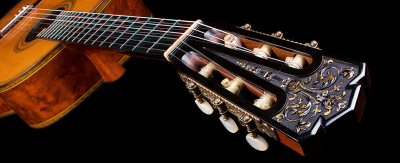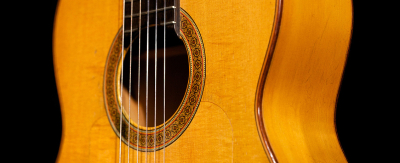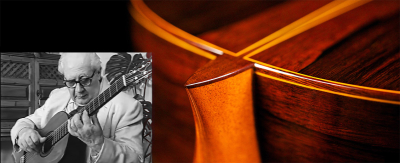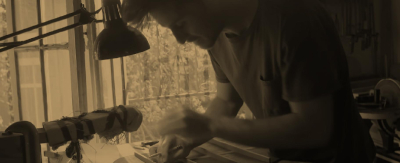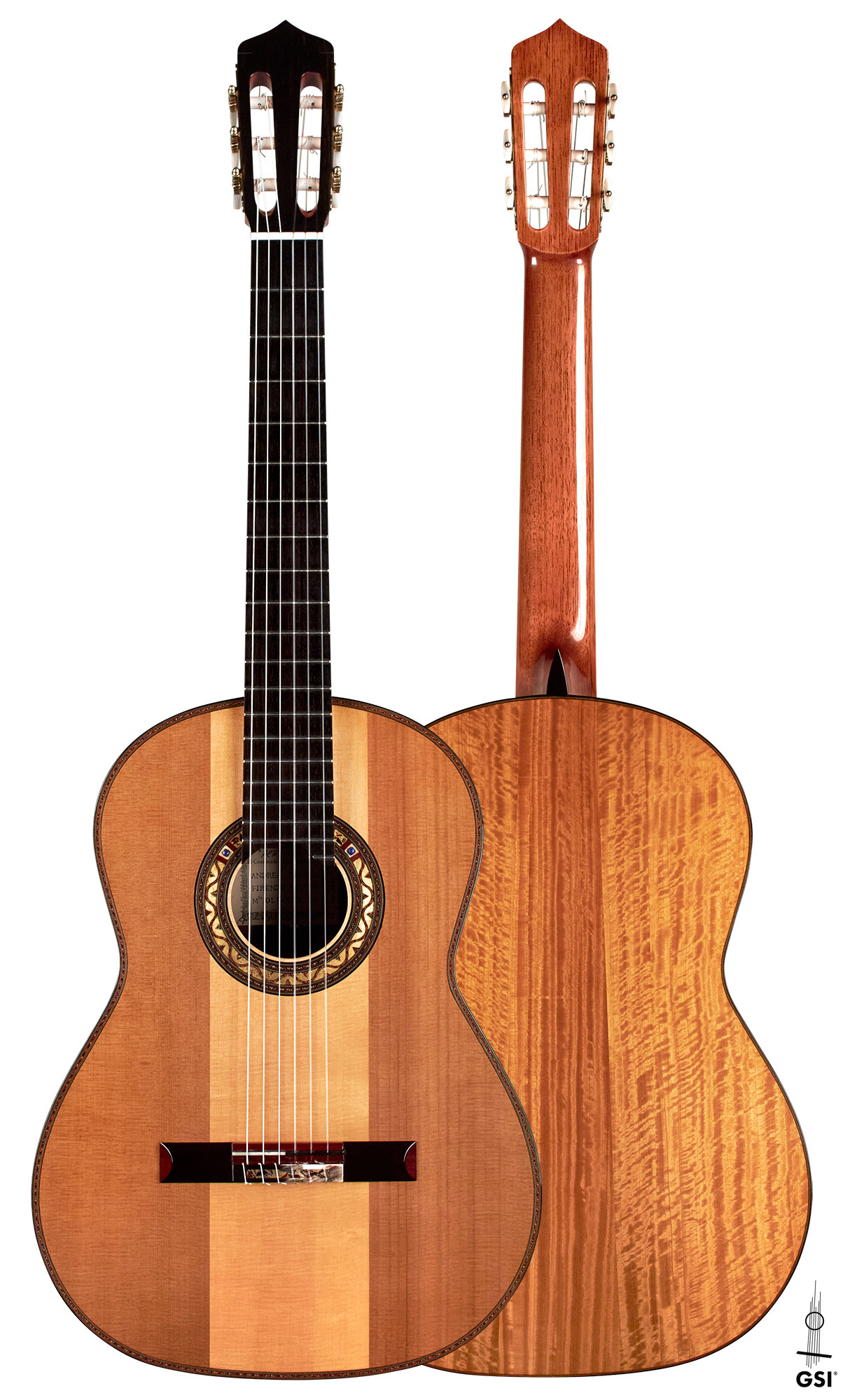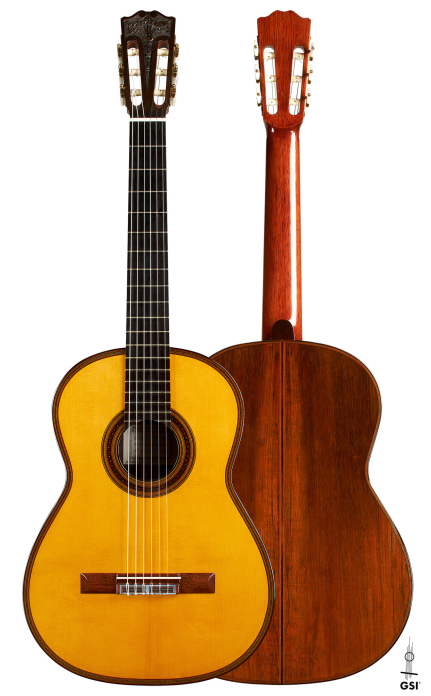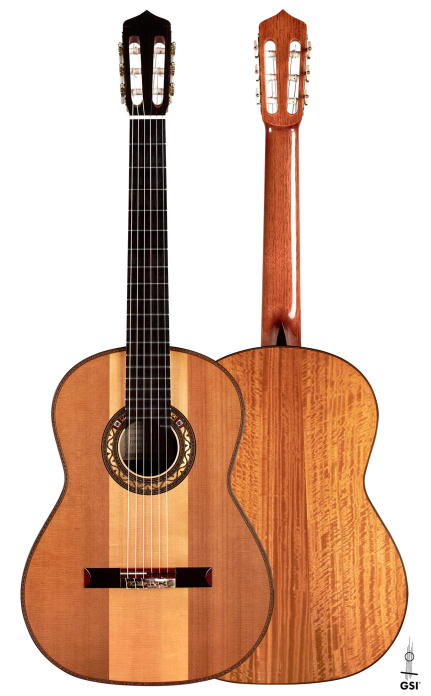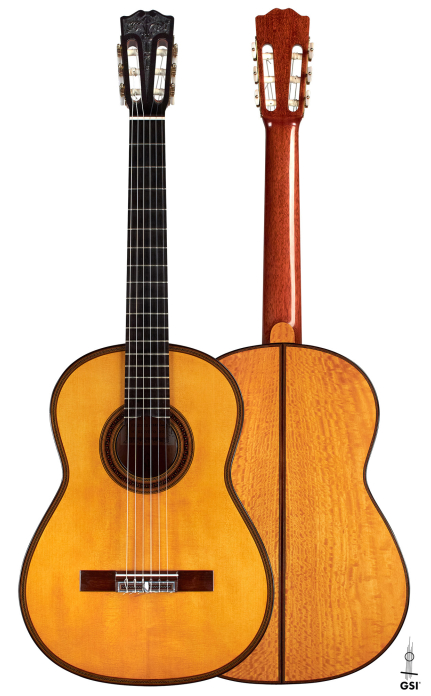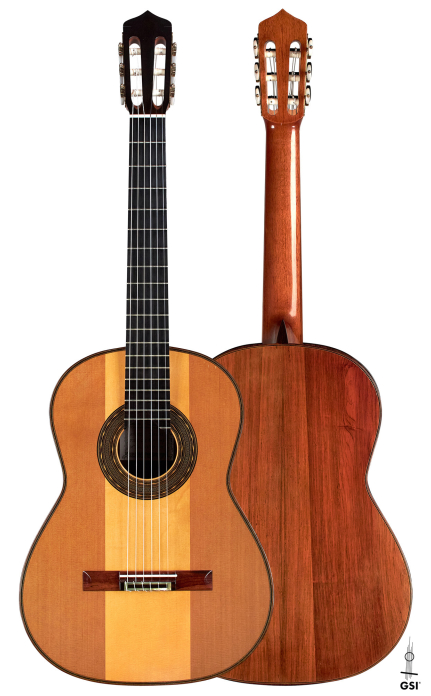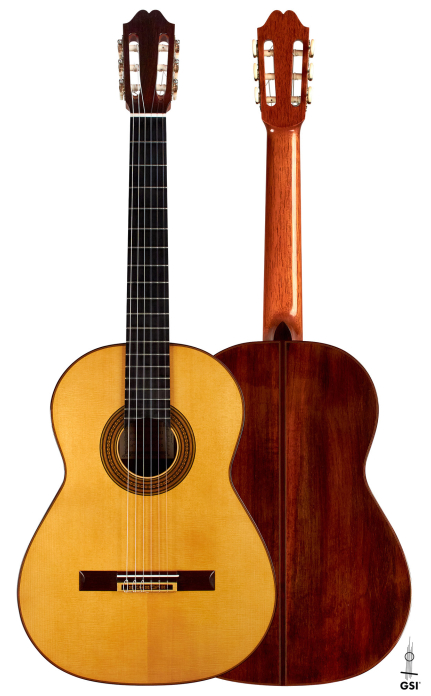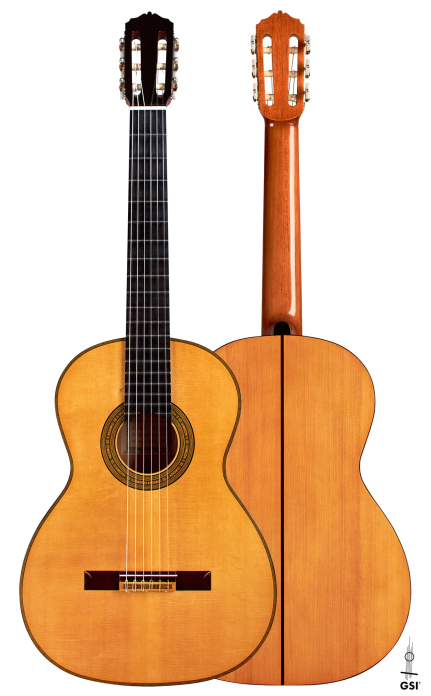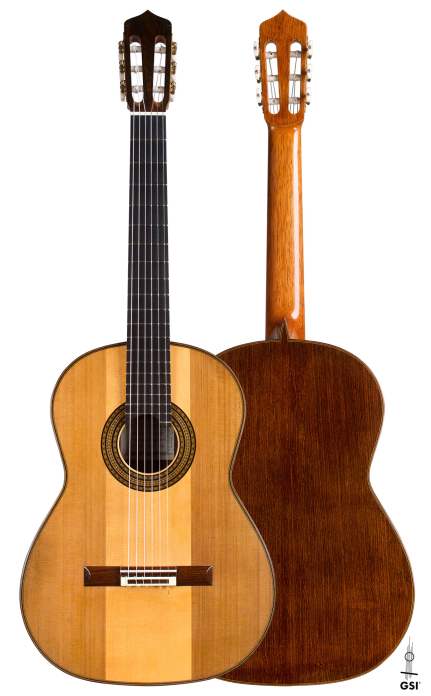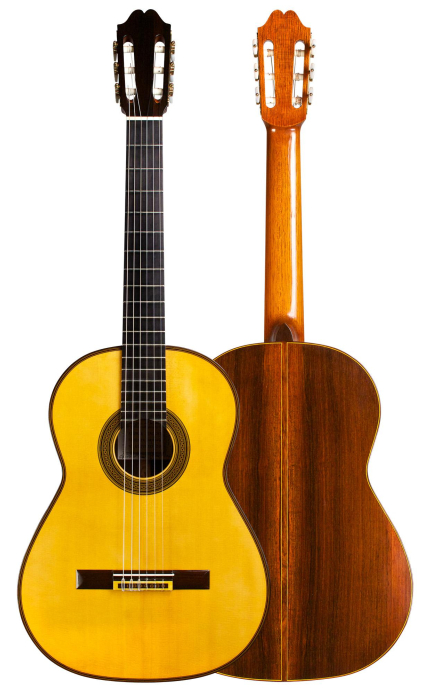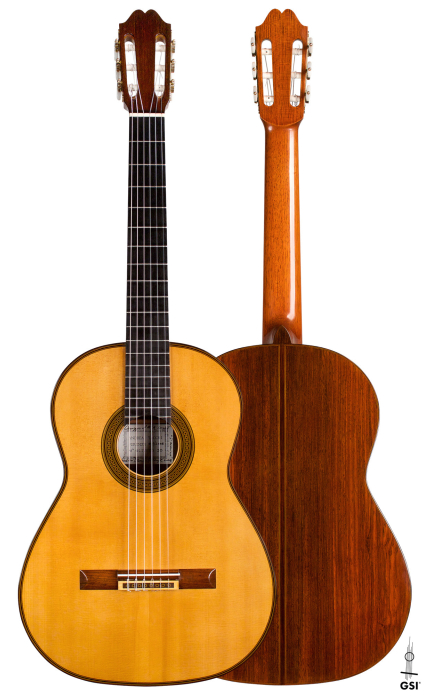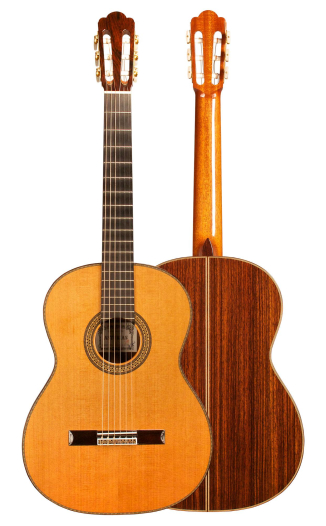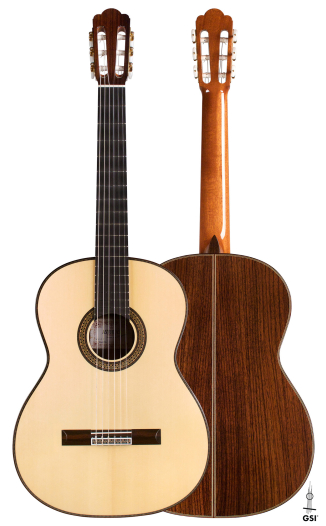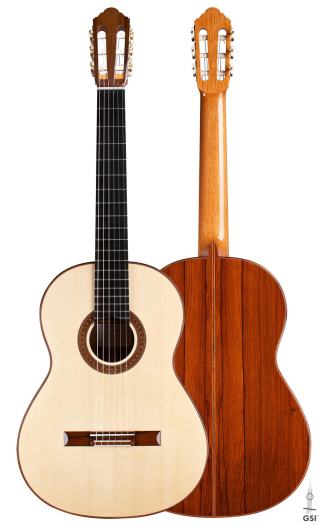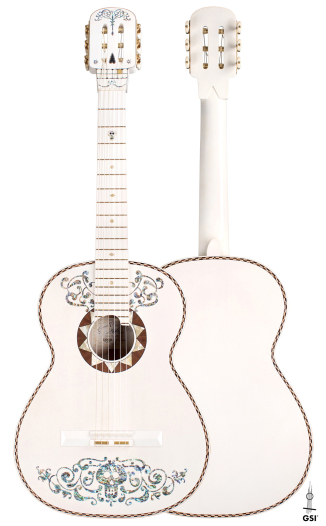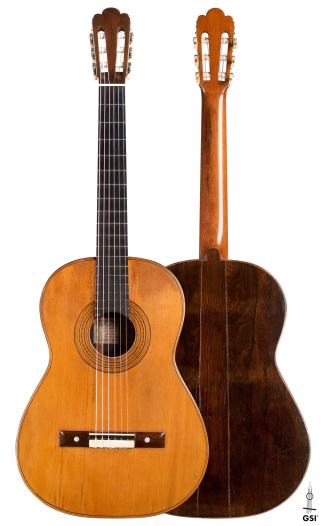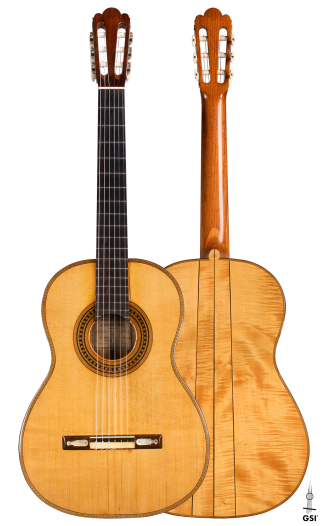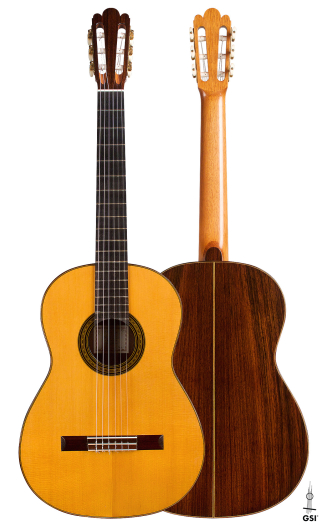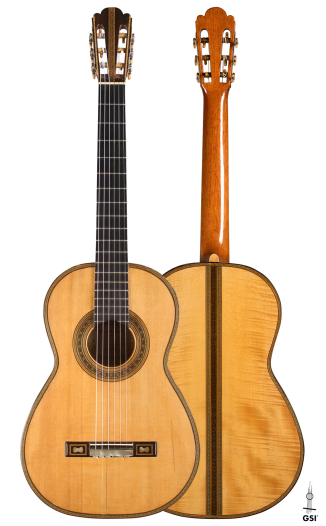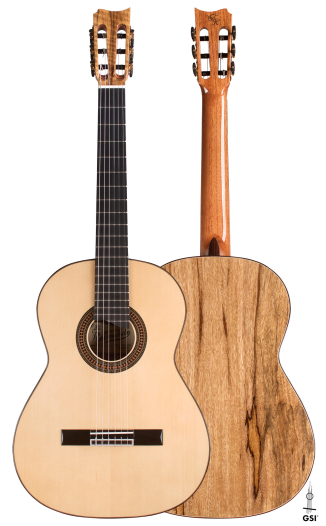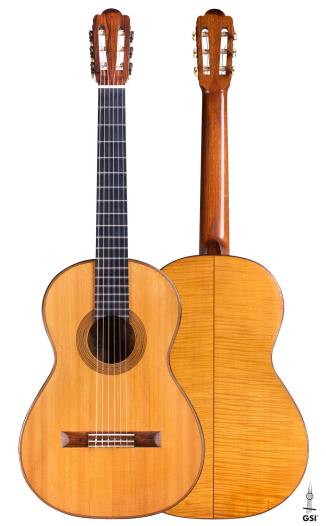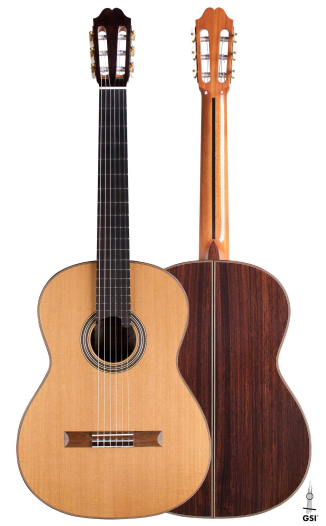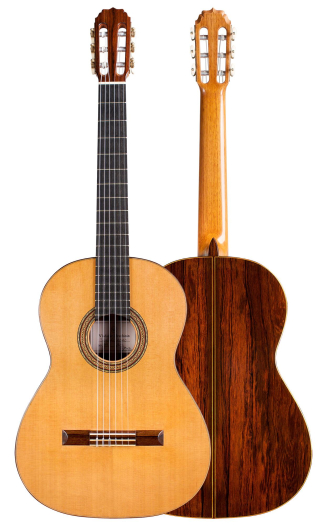2023 Andrea Tacchi "Coclea Thucea - Alter Ego" CS/SW
| Year | 2023 |
| Top | Cedar/Spruce |
| Back & Sides | Satinwood |
| Scale Length | 654 mm |
| Nut width | 52 mm |
| Finish | French Polish |
| Country | Italy |
| Condition | New |
| Exchange | ExchangePlus |
| Luthier | Andrea Tacchi |
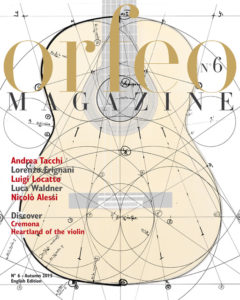 This is Andrea Tacchi's flagship model, the "Coclea Thucea". It is a fusing together of two different design ideas that were developed independently. The first idea was born in 1989, when Tacchi publicly unveiled his "Coclea" model – named after the Latin word for the part of the inner ear that transforms sound vibrations into the psychological sensations of volume, timbre, and tone. It is based on geometric and mathematical concepts that Tacchi discovered in researching old stringed instruments starting with S. F. Sacconi's book "The Secrets of Stradivari" where Sacconi made sketches of violins and cellos that described the rules of dimensions and proportions that most influenced acoustic properties. Further, Tacchi explored the relationships found in the careful combining of circles and spheres to generate his plantilla (outline shape of the guitar) as well as the side-view shape with its unique back and soundboard doming. The second idea (the "Thucea" part of the story) came as a result of Tacchi having evaluated many original Torres guitars and noticing Torres' use of asymmetrical soundboards - center seam locations and number of pieces of wood used by Torres for his tops seems to have been done to ensure that the stiffest pieces of woods were normally found under the bridge area. This realization led Tacchi to develop a three-piece top made with two pieces of western red cedar at the extremities and a central piece of European spruce in the middle, named "Thucea" from the union of the Latin words "Thuja Plicata" (cedar) and "Picea Excelsa" (spruce). Tacchi’s idea was to work with woods of different densities (as Torres had done) to maximize the efficiency of sound transmission across the various sections of his soundboards, resulting in improved response and projection.
This is Andrea Tacchi's flagship model, the "Coclea Thucea". It is a fusing together of two different design ideas that were developed independently. The first idea was born in 1989, when Tacchi publicly unveiled his "Coclea" model – named after the Latin word for the part of the inner ear that transforms sound vibrations into the psychological sensations of volume, timbre, and tone. It is based on geometric and mathematical concepts that Tacchi discovered in researching old stringed instruments starting with S. F. Sacconi's book "The Secrets of Stradivari" where Sacconi made sketches of violins and cellos that described the rules of dimensions and proportions that most influenced acoustic properties. Further, Tacchi explored the relationships found in the careful combining of circles and spheres to generate his plantilla (outline shape of the guitar) as well as the side-view shape with its unique back and soundboard doming. The second idea (the "Thucea" part of the story) came as a result of Tacchi having evaluated many original Torres guitars and noticing Torres' use of asymmetrical soundboards - center seam locations and number of pieces of wood used by Torres for his tops seems to have been done to ensure that the stiffest pieces of woods were normally found under the bridge area. This realization led Tacchi to develop a three-piece top made with two pieces of western red cedar at the extremities and a central piece of European spruce in the middle, named "Thucea" from the union of the Latin words "Thuja Plicata" (cedar) and "Picea Excelsa" (spruce). Tacchi’s idea was to work with woods of different densities (as Torres had done) to maximize the efficiency of sound transmission across the various sections of his soundboards, resulting in improved response and projection.
Because every guitar Andrea builds is intentionally unique (primarily in the aesthetic treatment), he therefore likes to find an appropriate name for each of his instruments. For this guitar, Andrea was "reflecting" on an instrument he had built for us in 2019, itself named "Riflesso" - featuring inlays that were symmetrical, partly yellow, partly red, which gave rise to a mirror image that inspired a fresh take on this idea for this new guitar, which he named "Alter Ego". By this, he sees himself as luthier, reflected in his creation. Pouring his entire self into his work - his knowledge, passion, skill and experience - into his craft. As the guitar emerges through the build process, it takes on its own life which it will carry into the future, well beyond the life of its creator, carrying the memory of its maker to future generations of guitarists and music lovers.
The aesthetics and structural elements of this guitar are quite striking and worth describing in some detail. Firstly, Andrea made a 3 piece back of his best satinwood, the center piece having a darker and denser satin than the exterior pieces. He laminated the entire back internally with 0.2 mm thickness of carbon fiber adding only 30 grams of weight but considerable added strength. The brilliant "gold" look of this wood is matched in the rosette where he has a base of gold leaf at the base of the entire central section. For the areas at the top of the rosette on either side of the fingerboard, silver was used instead of gold to enhance the brilliant blue of the lapis lazuli stones that create a relief. For the mosaics in the rosette and purflings, he wanted to escape the strict confines of geometric shapes and instead emphasize color for its own sake. He chose 10 colors, associated each with a number, and had them randomly arranged by a computer with the help of his friend Alessandro Platania, a mathemetician friend who developed the software that would render the most harmonious possible sequences. The rosette was idea started when Andrea wanted to experiment with mixing both wooden mosaics with painting. He did a series of "test rosettes" with Chinese dragons painted on the surface of the mosaic area. After some time, he ended up retaining the "wave" pattern of the dragons body shape but reverted to using wooden mosaics instead of paint. This wave pattern, flanked by triangles also of this mosaic, are floating in clear epoxy against the gold-leaf background providing a three dimensional effect which is mesmerizing to look at. The bridge is paduk with the wings veneered in ebony and the tie block is capped with Mouflon horn (from the island of Sardinia) with more of the purfling fragments and gold pieces in clear epoxy as in the rosette. Even the saddle itself is a composite of bone and carbon fiber to transmit vibration as efficiently as possible - Andrea sees this juncture of "string to body" in much the same delicate way as a needle on a record player. Fitted with Rodgers tuners and 20th fret.
As striking as the guitar looks, it cannot be overstated at how remarkable the quality of sound is as well. Simply put, the notable qualities of this guitar are an easy emission of sound, a great variety of timbre, polyphonic clarity, increased volume, great playability and relaxed, comfortable string tension. Indeed Tacchi's reputation as Italy's top living maker rests with the quality of sound that has been so attractive for so many years to many of the world's top performers. Overall a very sophisticated guitar, successfully achieving its intended aims, the primary of which is beauty of sound.
Videos
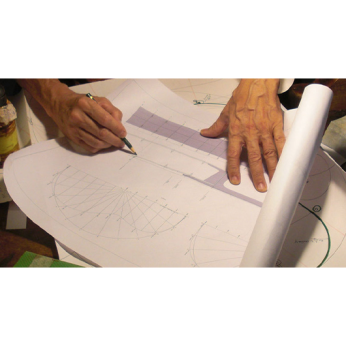
 This is Andrea Tacchi's flagship model, the "Coclea Thucea". It is a fusing together of two different design ideas that were developed independently. The first idea was born in 1989, when Tacchi publicly unveiled his "Coclea" model – named after the Latin word for the part of the inner ear that transforms sound vibrations into the psychological sensations of volume, timbre, and tone. It is based on geometric and mathematical concepts that Tacchi discovered in researching old stringed instruments starting with S. F. Sacconi's book "The Secrets of Stradivari" where Sacconi made sketches of violins and cellos that described the rules of dimensions and proportions that most influenced acoustic properties. Further, Tacchi explored the relationships found in the careful combining of circles and spheres to generate his plantilla (outline shape of the guitar) as well as the side-view shape with its unique back and soundboard doming. The second idea (the "Thucea" part of the story) came as a result of Tacchi having evaluated many original Torres guitars and noticing Torres' use of asymmetrical soundboards - center seam locations and number of pieces of wood used by Torres for his tops seems to have been done to ensure that the stiffest pieces of woods were normally found under the bridge area. This realization led Tacchi to develop a three-piece top made with two pieces of western red cedar at the extremities and a central piece of European spruce in the middle, named "Thucea" from the union of the Latin words "Thuja Plicata" (cedar) and "Picea Excelsa" (spruce). Tacchi’s idea was to work with woods of different densities (as Torres had done) to maximize the efficiency of sound transmission across the various sections of his soundboards, resulting in improved response and projection.
This is Andrea Tacchi's flagship model, the "Coclea Thucea". It is a fusing together of two different design ideas that were developed independently. The first idea was born in 1989, when Tacchi publicly unveiled his "Coclea" model – named after the Latin word for the part of the inner ear that transforms sound vibrations into the psychological sensations of volume, timbre, and tone. It is based on geometric and mathematical concepts that Tacchi discovered in researching old stringed instruments starting with S. F. Sacconi's book "The Secrets of Stradivari" where Sacconi made sketches of violins and cellos that described the rules of dimensions and proportions that most influenced acoustic properties. Further, Tacchi explored the relationships found in the careful combining of circles and spheres to generate his plantilla (outline shape of the guitar) as well as the side-view shape with its unique back and soundboard doming. The second idea (the "Thucea" part of the story) came as a result of Tacchi having evaluated many original Torres guitars and noticing Torres' use of asymmetrical soundboards - center seam locations and number of pieces of wood used by Torres for his tops seems to have been done to ensure that the stiffest pieces of woods were normally found under the bridge area. This realization led Tacchi to develop a three-piece top made with two pieces of western red cedar at the extremities and a central piece of European spruce in the middle, named "Thucea" from the union of the Latin words "Thuja Plicata" (cedar) and "Picea Excelsa" (spruce). Tacchi’s idea was to work with woods of different densities (as Torres had done) to maximize the efficiency of sound transmission across the various sections of his soundboards, resulting in improved response and projection.
Because every guitar Andrea builds is intentionally unique (primarily in the aesthetic treatment), he therefore likes to find an appropriate name for each of his instruments. For this guitar, Andrea was "reflecting" on an instrument he had built for us in 2019, itself named "Riflesso" - featuring inlays that were symmetrical, partly yellow, partly red, which gave rise to a mirror image that inspired a fresh take on this idea for this new guitar, which he named "Alter Ego". By this, he sees himself as luthier, reflected in his creation. Pouring his entire self into his work - his knowledge, passion, skill and experience - into his craft. As the guitar emerges through the build process, it takes on its own life which it will carry into the future, well beyond the life of its creator, carrying the memory of its maker to future generations of guitarists and music lovers.
The aesthetics and structural elements of this guitar are quite striking and worth describing in some detail. Firstly, Andrea made a 3 piece back of his best satinwood, the center piece having a darker and denser satin than the exterior pieces. He laminated the entire back internally with 0.2 mm thickness of carbon fiber adding only 30 grams of weight but considerable added strength. The brilliant "gold" look of this wood is matched in the rosette where he has a base of gold leaf at the base of the entire central section. For the areas at the top of the rosette on either side of the fingerboard, silver was used instead of gold to enhance the brilliant blue of the lapis lazuli stones that create a relief. For the mosaics in the rosette and purflings, he wanted to escape the strict confines of geometric shapes and instead emphasize color for its own sake. He chose 10 colors, associated each with a number, and had them randomly arranged by a computer with the help of his friend Alessandro Platania, a mathemetician friend who developed the software that would render the most harmonious possible sequences. The rosette was idea started when Andrea wanted to experiment with mixing both wooden mosaics with painting. He did a series of "test rosettes" with Chinese dragons painted on the surface of the mosaic area. After some time, he ended up retaining the "wave" pattern of the dragons body shape but reverted to using wooden mosaics instead of paint. This wave pattern, flanked by triangles also of this mosaic, are floating in clear epoxy against the gold-leaf background providing a three dimensional effect which is mesmerizing to look at. The bridge is paduk with the wings veneered in ebony and the tie block is capped with Mouflon horn (from the island of Sardinia) with more of the purfling fragments and gold pieces in clear epoxy as in the rosette. Even the saddle itself is a composite of bone and carbon fiber to transmit vibration as efficiently as possible - Andrea sees this juncture of "string to body" in much the same delicate way as a needle on a record player. Fitted with Rodgers tuners and 20th fret.
As striking as the guitar looks, it cannot be overstated at how remarkable the quality of sound is as well. Simply put, the notable qualities of this guitar are an easy emission of sound, a great variety of timbre, polyphonic clarity, increased volume, great playability and relaxed, comfortable string tension. Indeed Tacchi's reputation as Italy's top living maker rests with the quality of sound that has been so attractive for so many years to many of the world's top performers. Overall a very sophisticated guitar, successfully achieving its intended aims, the primary of which is beauty of sound.
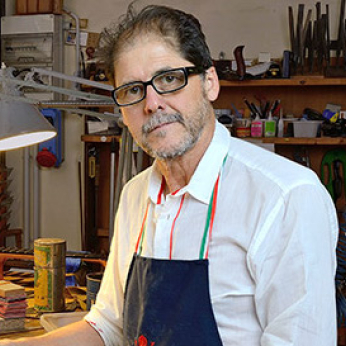
A native of Florence, Italy, Andrea Tacchi is arguably Italy's foremost contemporary luthier and is ranked among the top handful in the world by players and collectors alike. His interest in guitar making started very early in his life - he built his first guitar at age 15. In 1977 he began the serious study of guitar making with Argentinian luthier Ricardo Brané. After Brané’s death, Tacchi traveled extensively (starting in the early 1980s) in pursuit of mastering his craft. In Spain he spent time in the workshops of Jose Ramirez III, Paulino Bernabe Sr, and Francisco & Gabriel Fleta; and in England with Jose Romanillos. But perhaps his most influential trips were those to France where he befriended and consulted with Robert Bouchet and Daniel Friederich, whose approaches and aesthetics would greatly impact Tacchi's developing style. His reputation internationally was boosted in 1985 when he competed in the Concours International des Facteurs de Guitare organized by Robert Vidal of Radio France - Tacchi won first prize for Aesthetic Qualities and second general prize for Acoustic Qualities. His instruments have been played by several notable guitarists including Filomena Moretti, Flavio Cucchi, Carlo Marchione, Antigoni Goni, Robert Gruca, Colin Davin, Minoru Inagaki, and Marcelo Kayath, while others belong to important private collections. Two of his guitars are in the collection of the Conservatorio Luigi Cherubini in Florence, Italy.
Feel free to contact us with any questions. It’s what we’re here for!

